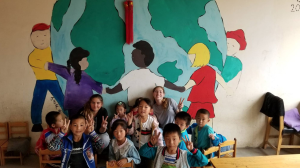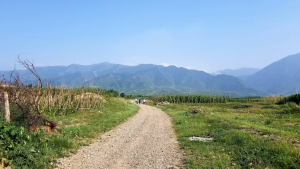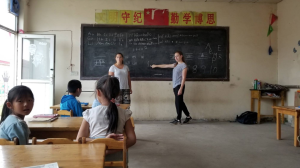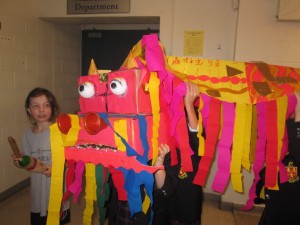 Last summer, I travelled to China on a trip organized by Me to We, a non-governmental organization which helps create sustainable change by transforming local and global communities. J’ai voyagé avec sept autres étudiants autour de mon âge venant de Montréal et New York, ainsi que deux animateurs de Me to We. From my past experiences at the Round Square conference in Argentina last year, as well as volunteering in the local community, I was always interested in community service. However, I can honestly tell you that this trip changed my life.
Last summer, I travelled to China on a trip organized by Me to We, a non-governmental organization which helps create sustainable change by transforming local and global communities. J’ai voyagé avec sept autres étudiants autour de mon âge venant de Montréal et New York, ainsi que deux animateurs de Me to We. From my past experiences at the Round Square conference in Argentina last year, as well as volunteering in the local community, I was always interested in community service. However, I can honestly tell you that this trip changed my life.
 Nous avons passé nos premiers jours à Beijing en visitant des sites bien connus, tels que Tiananmen Square, des temples Buddistes, et nous avons même monté la Grande Muraille de Chine! Nous avons ensuite conduit pendant plus de six heures à une communauté rurale, Gufubao. It was a relief to finally be away from the pollution and smog of Beijing, and beautiful is not a good enough word to describe where we were. Nous étions complètement entourés d’énormes montagnes et des champs de maïs. It was really amazing for us to meet the kind locals, who take great pride in their natural environment, regardless of the extreme poverty that they live in. In addition, they always ensure that their environment is being taken care of, by being cautious of how much water and food they consume, as well as constantly making sure that their agriculture is properly cultivated and protected. Some locals even took us on hikes around the community, where we saw some unbelievable views.
Nous avons passé nos premiers jours à Beijing en visitant des sites bien connus, tels que Tiananmen Square, des temples Buddistes, et nous avons même monté la Grande Muraille de Chine! Nous avons ensuite conduit pendant plus de six heures à une communauté rurale, Gufubao. It was a relief to finally be away from the pollution and smog of Beijing, and beautiful is not a good enough word to describe where we were. Nous étions complètement entourés d’énormes montagnes et des champs de maïs. It was really amazing for us to meet the kind locals, who take great pride in their natural environment, regardless of the extreme poverty that they live in. In addition, they always ensure that their environment is being taken care of, by being cautious of how much water and food they consume, as well as constantly making sure that their agriculture is properly cultivated and protected. Some locals even took us on hikes around the community, where we saw some unbelievable views.
 Pendant dix jours, nous avons enseigné l’anglais à des enfants défavorisés, et nous avons travaillé sur la construction d’un enclos pour des cochons, la première source de revenue pour la communauté. L’école était un bâtiment de briques avec trois salles de classe et un petit terrain de jeu dehors, les deux construits par Me to We. Lorsque nous sommes arrivés, nous avons été accueillis par une cinquantaine d’élèves, âgés entre cinq et 12 ans, qui étaient très contents de nous voir. Since it was July, all of these students were in the middle of their summer holiday, so you would think that going to school in 40 degree weather for the entire day was not exactly what they wanted to do, right? Wrong. These kids were more than happy to do so. Puisque les enfants parlaient très peu d’anglais, ils étaient très excités de nous montrer qu’ils pouvaient compter de un à 10, et qu’ils connaissaient les couleurs de l’arc-en-ciel.
Pendant dix jours, nous avons enseigné l’anglais à des enfants défavorisés, et nous avons travaillé sur la construction d’un enclos pour des cochons, la première source de revenue pour la communauté. L’école était un bâtiment de briques avec trois salles de classe et un petit terrain de jeu dehors, les deux construits par Me to We. Lorsque nous sommes arrivés, nous avons été accueillis par une cinquantaine d’élèves, âgés entre cinq et 12 ans, qui étaient très contents de nous voir. Since it was July, all of these students were in the middle of their summer holiday, so you would think that going to school in 40 degree weather for the entire day was not exactly what they wanted to do, right? Wrong. These kids were more than happy to do so. Puisque les enfants parlaient très peu d’anglais, ils étaient très excités de nous montrer qu’ils pouvaient compter de un à 10, et qu’ils connaissaient les couleurs de l’arc-en-ciel.
 Why did I choose to write about teaching English to students in China? Well, we later learned that only 1% of students who have attended the school in Gufubao go on to university. That’s only seven or eight students at LCC progressing to CEGEP or college. Think about that for a second: all of the hard work that we put into our studies every day would only pay off for seven or eight of us in the Junior, Middle and Senior Schools combined!
Why did I choose to write about teaching English to students in China? Well, we later learned that only 1% of students who have attended the school in Gufubao go on to university. That’s only seven or eight students at LCC progressing to CEGEP or college. Think about that for a second: all of the hard work that we put into our studies every day would only pay off for seven or eight of us in the Junior, Middle and Senior Schools combined!
We’re so lucky to go to LCC, with its amazing education programs and opportunities, inside and outside the classroom. Seeing how much the students in Gufubao appreciated going to school made me reflect on how I see education. Now, I go to school every day wanting to learn more. I’m excited to see where my education will take me, so I can use it to make a difference. Going to school is a privilege, and I think it’s important for everyone to realize that, just like I have. – Meghan Fersten ’18

